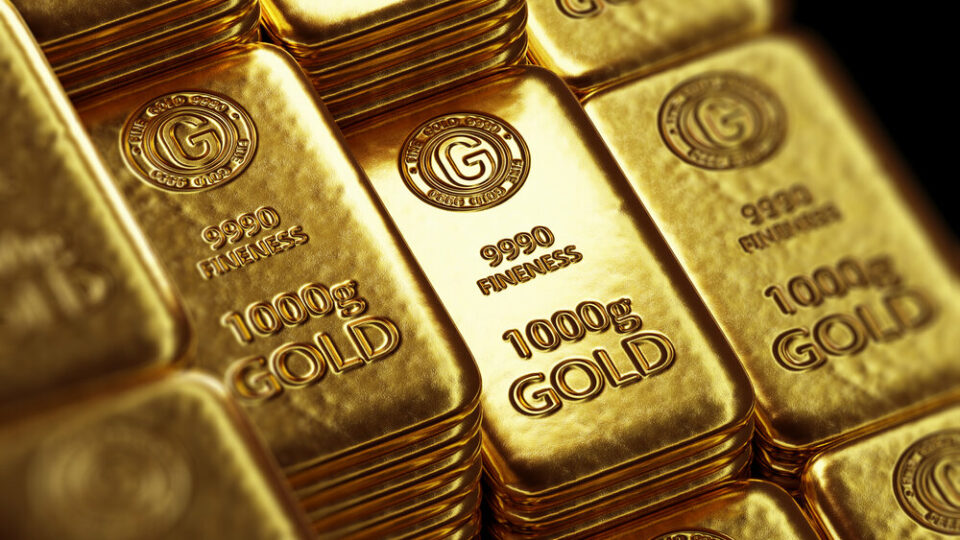The stock market is a casualty in the Fed’s fight against inflation. Will the entire economy follow? If so, will the Fed make a dovish pivot?
Key Takeaways:
- Gold needs interest rates to fall, the dollar to weaken, or the market to lose faith in the Fed. If the Fed turns dovish, all of these things could happen at once.
- The Fed Funds Rate is rising at the fastest pace since the 1980s. How much pain is the Fed willing to inflict to bring down inflation?
- If the FOMC starts loosening policy, investors will realize they have lost control of the economy. Gold serves as a hedge against the disasters of central banking.
Gold Looks for a Trigger
Gold is trading around its 200-day moving average, seemingly unable to find much upward momentum. Rising interest rates and a rising U.S. dollar, two of gold’s primary headwinds, have been the story of 2022.
Still, gold is slightly up on the year. To find any real bullish momentum, one of three things needs to happen:
- Interest rates start to fall. The Fed is dead set on cranking up interest rates while they can, although they could quickly change their minds if the U.S. economy takes a turn for the worse and unemployment starts rising.
- The U.S. dollar starts dropping. This could happen if U.S. inflation remains stubbornly high or the Fed shifts to a more dovish policy.
- Investors lose hope in the stock market and turn toward safe-havens. So far, investors have only revoked a small percentage of the funds invested in the stock market, failing to find any alternatives. If the U.S. enters a recession or the S&P 500 officially enters a bear market, investors could begin a mass migration to gold.
Raising Rates
As inflation took the world by storm, the “Federal Funds Rate” climbed into news headlines. The Fed Funds Rate is the Fed’s primary tool to adjust monetary policy, which means it has drastic implications for the financial markets and the economy.
When the Fed raises rates, it effectively increases the price of money. Right now, the Fed is cranking up the Fed Funds Rate to tighten monetary policy and fight inflation. Fed officials expect to raise the Fed Funds rate by 50 basis points (0.5%) at both its June and July meetings, which would bring it to around 2%.
The Fed has not increased rates this fast since the 1980s.
What is the Fed Funds Rate?
Commercial banks borrow money from each other all the time. If one bank has extra reserves, it can lend out those funds on a short-term basis to another bank that needs extra cash. The Fed Funds Rate refers to the interest rate the lending bank charges the borrowing bank.
By adjusting the Fed Funds Rate, the Federal Reserve recommends how much the lending bank should charge in interest. The Federal Open Market Committee (FOMC) meets eight times per year to decide the Fed Funds Rate. From March 2020 through January 2021, the Fed held the Fed Funds Rate near zero. Banks could basically borrow money for free.
The Fed Funds Rate serves as a baseline for all other interest rates, including bond yields, mortgages, and credit cards. The chart below shows the 2-year, 5-year, and 10-year treasury yields on top of the Fed Funds chart. As you can see, all interest rates have been skyrocketing this year.
Fighting Inflation
The Fed Funds Rate also tends to follow the Consumer Price Index. When inflation starts rising, the Fed steps in to increase the price of money and decrease the money supply.
For example, in 1980, inflation peaked at 14.76%. Soon after, the Fed raised the Fed Funds Rate to 19.10%. Right now, the Fed Funds Rate is below 1% while inflation sits at 8.26%. The Fed has a long way to go before catching up with CPI.
The problem is, rising rates have absolutely crushed the stock market this year.
Faith in the Fed
So far, the Fed officials have stuck to their guns. If you are invested in the stock market, too bad. It will continue to be a casualty in the Fed’s fight against inflation.
The question is, will the Fed reverse its path? When and if the Fed Funds Rate starts hurting the economy, people will be much less receptive to monetary tightening. For example, if the U.S. enters a recession and unemployment starts skyrocketing, the Fed will find it much more difficult to continue cranking up the price of money.
In that case, the Fed will lose all credibility. The Fed needs to maintain the illusion of control. Recession on the horizon? Inflation crushing the consumer? No problem, the Federal Reserve can fix anything!
Until…they can’t. At this point, a dovish policy pivot would prove that the Fed cannot engineer a soft landing, cannot control inflation, and cannot prevent a recession. This situation would likely result in a massive increase in the price of gold because gold serves as a hedge against central banking.
When investors lose faith in the Fed, they purchase gold.
Secure gold savings, without the excessive fees
Your weekly gold market commentary comes from our internal team of researchers and technical experts. Vaulted gives modern investors access to physical gold ownership at the best cost structure in the industry. With personal advising from industry experts and access to premier precious metals strategies, Vaulted is the key to life-long financial prosperity. Start protecting your portfolio today.
As always, thank you so much for reading – and happy investing!
Additional Resources:
Global equities fall despite positive U.S. economic data, dollar rises (Reuters)
Fed Starts Experiment of Letting $8.9 Trillion Portfolio Shrink (Yahoo Finance)
Federal Reserve’s Mild Inflation Forecasts Need Explaining (Bloomberg)
Eurozone inflation hits record 8.1% amid rising energy costs (AP News)











